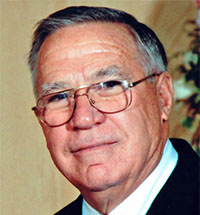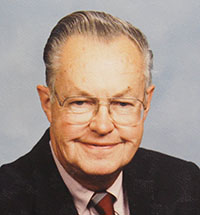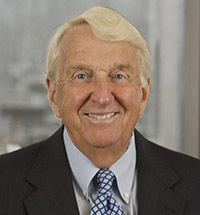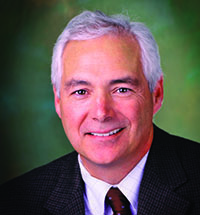School of Built Environment
605 S. Warren
GRN 227
Big Rapids MI 49307
(231) 591-3773
The Michigan Construction Hall of Fame welcomed four new inductees during a formal ceremony held at Ferris State University on Thursday, October 24, 2019.
Selection for the Michigan Construction Hall of Fame is based on nominees’ technical, managerial and leadership achievements within construction and related industries, as well as service to the profession and community.
The Michigan Construction Hall of Fame is located in Ferris’ Granger Center for Construction and HVACR on the Big Rapids campus and serves as a permanent site to recognize leaders of the Michigan construction industry and their achievements.

Clyde Jones grew up within a Royal Oak construction family where his father owned a small electrical contracting company that focused primarily on commercial work. On the weekends, Clyde’s father would take him to those job sites, introducing him to the basics of electrical construction.
As Clyde was getting ready to graduate from high school his father sold the business. Recognizing his personal interest in electrical construction, Clyde applied for and was accepted to the International Brotherhood of Electrical Workers Local 58 apprenticeship program.
The training was broadly based – classroom studies and on-site project work. Apprentices were rotated so they could experience all different types of electrical construction. Following apprenticeship graduation Clyde began working full-time in the industry with journeyman and foreman status.
Clyde expanded his experience with several contractors in the Detroit area over the next 10 years. After working for only one year with Centerline Electric, the owner contacted Clyde and inquired if he would consider purchasing the business. Doubtful of his interest in becoming an owner/contractor, he asked his wife to attend the meeting and voice her views.
At that time, Centerline Electric had two employees, two service trucks, and approximately 75 service customers in the tool-and-die, press plants and similar industries. The company revenue was based upon time-and-materials. At that meeting, Clyde expressed his interest in the business, but stated he did not have the funds to purchase it. With his wife’s agreement, plus a down payment, a 10-year contract, and short-term financing through the owner, Clyde and his wife, Cora, became owners of Centerline Electric. It was truly a family business with Clyde running the contracting side and Cora running the financial and accounting side.
To compensate for no established line of credit, Centerline Electric maintained their existing service customers while starting to bid new projects. Like many start-up businesses today, it was a 24 hour-a-day working dedication with the office phone ringing in their home for the first 35 years.
In 1979, Centerline Electric won its first major commercial project in Birmingham, Michigan – a 10-story building with commercial and residential space. This was the needed spark that led to larger commercial projects. In 1985, they acquired a medical office building and parking structure project and an introduction to the medical segment of the industry. With the expansion of Metro airport to accommodate Northwest Airlines, Centerline Electric also expanded, including bringing in a 120kV electrical service with five miles of underground construction and 138 KV cable that required special cable with unique splicing. Centerline’s performance resulted in 34 years of continuous work at the airport.
Centerline’s introduction into data center construction was enhanced by EDS’s building its first data center in Michigan in the mid ‘80s. The company expanded to almost 50 employees and work procurement included mainly hard-dollar bids. Selected skilled employees moved from the field into the office to handle the more complex project management.
Under Clyde’s leadership, today’s Centerline Electric employs approximately 350 employees with gross sales around $100 million. Technology use has expanded into the use of 3D modeling and prefabrication. Many of their projects utilize design-assist and fee-based contracts.
Clyde’s leadership has focused on key positions in the construction industry such as 35 years as a Board Member of the Southeastern Michigan Chapter of NECA (National Electrical Contractors Association) and 31 years as Chairman of the Joint Electrical Apprentice Training Committee.
During his tenure and as a leader on the Apprentice Training Committee, a state-of-the-art 50,000 SF facility was built in Warren that was a fundamental element of a revised training methodology. Apprenticeship certification became a 5-year program (rather than 4) to accommodate the changing requirements and technology in the industry. It also became more “hands-on” to meet industry expectations. A journeyman training process was expanded in the evening to allow journeymen to develop additional skills.
Clyde did not forget his positive experience as a young man as a member of the Boy Scouts. His involvement continued with Centerline Electric participating in their yearly “Mix Fix” where multiple contractors work on the D-bar-A Scout Ranch in Metamora readying the camp for the Scouts. Centerline has provided up to 50 electricians at this event resulting in Clyde receiving the Beaver Award for distinguished service.
Clyde had many mentors who helped him start the business. While his father advised Clyde to work for someone else and avoid the responsibility of running a company, he was extremely supportive of Clyde and Cora’s decision to purchase Centerline, often visiting jobsites with Clyde’s superintendents.
Clyde and Cora are now retired on their farm in Almont. Their son James retired from Centerline as a journeyman electrician in 2017. Their daughter, Michelle, worked in the office and married an electrician, Tim Randall (who also retired in 2017), reinforcing Clyde’s influence of keeping electricity flowing through the family.

Born and raised in the St. Joseph/Benton Harbor area, Burt Pearson Sr.’s family was involved as an integral part of the community. Burt attended the original St. Joseph High School which was constructed by his father and married in the church partially funded and built by his father, as founder of Pearson Construction. At the age of 12 he began sweeping floors at the office of Pearson Construction. At 13, he was driving his father to jobsites in Kentucky while his father worked in the front seat.
Burt attended Northwestern University to study engineering, but was drafted and served in the Army Air Corps in Washington D.C. When the war ended, he chose Western Michigan University and changed his major to study business administration to prepare him for working for the construction company founded by his father. He chose the construction career path offered him and he never worked a job in another industry.
He began work as a carpenter in the field to really learn the business. His first job as a Project Manager took him to Escanaba constructing their water plant. Pearson Construction completed client work around the country, but Burt’s projects were primarily in Michigan. Burt was instrumental in establishing Pearson Engineering, Inc. enabling the company to provide unique design build services to its clients – one of the first full-service, turnkey design and construction firms in the 1950s.
While working on Pearson’s largest project to date, the Berrien County Courthouse, Burt’s father passed away unexpectedly. Burt was elected President by his brothers and maintained the company’s strategy to achieve complete client satisfaction plus retaining its focus on the local economy of southwest Michigan. As the prominent builder in the St. Joseph/Benton Harbor area, Burt was well acquainted with the regional business owners. His business philosophy, embraced by the company, was “to do what’s right, even when you’re wrong, and even when you have been wronged, you need to do what is right.” This put added pressure on Burt, but he believed that the company’s best unintended salespersons were their competition - that while they might do one job for a client, that client always returned to Pearson.
Burt became President the same year that Pearson Construction expanded into metal prefabricated buildings – just beginning to be introduced into the mainstream of the construction industry. The advantage of becoming an authorized dealer was delivery and economic efficiency – having a building pre-engineered and sent to a site with all of its components matched Burt’s desire for the company to have full control of a project. He kept the company focused on project types in which they had experience and skills – they could be very difficult projects, but they were within their capability – commercial structures, schools, hospitals, factories, and water plants.
Burt served as the President of Pearson for 31 years and then an additional 9 years as Chairman of the Board of Directors. He was extremely dedicated to the business, working 7 days a week. It is rare to find a picture of him not dressed in a suit and tie. The annual family vacation revolved around the Associated General Contractors yearly gathering – out of his sense of obligation to his family, employees, and the community, plus his love of the industry.
He was particularly proud that Pearson Construction self-performed many of the trades’ work used on the projects they constructed - and that most of those tradespeople were local to the area - thereby positively impacting the local economy. He was proud to be able to help his employees when needed, whether it was financial or simply a favor, without an expectation of repayment. Most employees started and ended their construction careers at Pearson.
Burt’s honesty and integrity with clients and employees are the basis for the company’s Seven Principles: People, Performance, Professionalism, Progressive, Passion, Perseverance, Partnership. He treated everyone fairly, even to the extent of offering client profit sharing based upon a project’s efficiency - a very uncommon practice in the construction industry.
Burt was proud of every building the company constructed and his client contacts. He would often drive new employees around town showing them all the company’s projects constructed that year. He was most proud of the Berrien County Courthouse project. One of the construction events he most enjoyed was bid day with its flurry of activity and he thrived on physically delivering bids.
He never truly retired from the family business when his son took over. He continually visited jobsites and was actively involved. Even when unable to physically get to the jobsite, schedules and budgets were brought to him for his review. When he was once asked about his hobbies, he replied that it was “working in our construction company.”

Bill Pulte, the Founder of Pulte Homes (PHM-NYSE), acquired his love of construction by way of his first car purchase at age 16. Bill’s dad inquired how he intended to fill said car with gas, and Bill suggested an allowance. His father suggested a job, so Bill got a job as a carpenter and mason.
In 1950, Bill started his namesake building company, William J. Pulte, Inc. at age 18, fresh out of high school. With a group of friends, he constructed a five-room bungalow near the Detroit City Airport. He quickly realized that he wanted to let others perform the actual building while he did the “thinking.”
In 1959, he introduced his company’s first subdivision to Bloomfield Hills. He studied his competitors and the Henry Ford production methods that focused upon standardization. In one subdivision he built and sold the exact same floor plan for every home, only varying the elevations. It became one of his most successful developments.
In 1969, he took the company public as its Chairman and President, renaming the company Pulte Home Corporation. The company provided Entry-Level Homes for middle class Americans. Bill believed you had to offer something unique to attract customers from considering other builders, e.g. a fireplace in a neighborhood without fireplaces, or the first community with trees or brick fronts, or side-entry garages.
In the 1970s and 1980s, Pulte always focused on delivering a quality product at an affordable price. He was an innovator in the industry, often developing new methods that would later (and quickly) be adopted by competitors. Pulte incorporated this methodology into his standard building process. He developed a comprehensive training program for new employees that included 120 hours of classroom learning in their first year. New employees were selected for their people skills as well as their technical skills. Subcontractor scope-of-work reviews were completed line-by-line to ensure complete understanding and quality process compliance. He treated subcontractors as part of the Pulte family so they would strive for the same quality results. This focus on quality continued full-circle throughout the customer interface. Pulte’s focus on quality started with the customer, assuring an understanding of the homeowner’s wants and needs: what they want; what they can afford; and then assuring them Pulte would provide the best value for their money. Bill realized that the company must provide an attractive product proposal up-front to enable the customer to commit. Resolution of building warranty issues and how they were handled with the customer became paramount. To Bill, warranty service was not about simply fixing the problem, but how the fix was resolved - particularly the attitude of the service employee.
In 1990, Pulte Homes was the largest home-building firm in the country, eventually producing 50,000 units per year – a number once thought unattainable in the homebuilding industry. Bill also established a mortgage company and a federal savings and loan company. He acquired other homebuilding firms that served alternatively priced markets, allowing Pulte Homes to serve homeowners through all stages of their lives.
By the time Bill retired from PulteGroup in 2010, the company had produced, throughout the country, over 500,000 homes and was described by Fortune magazine as one of the world’s most admired companies. Bill remained the company’s largest shareholder, unafraid to voice his opinion regarding what was best for the company and its customers.
In his 60 years in the industry, there were two items Bill most enjoyed on a continuous basis: the great people with whom he came into contact in the business; and seeing success/progression every day on the project site. Bill realized that to be successful in this business, the focus had to be on the trades, not just finance. For Bill, understanding the basics of carpentry and building was fundamental.
Bill attributed much of his success to his parents who gave him great confidence and also took the time to show him and his siblings how to do things. Importantly after the task was learned, they stepped aside.
Bill wished to be remembered for being kind and fair to everyone. His belief was that his employees should put “God First, Family Second, and The Pulte Family Third.” These behavioral traits extended to his interface with his family, employees, his subcontractors, and to those in need. Bill was a quiet philanthropist who donated millions to many organizations including International Samaritan, Cornerstone Schools, Detroit area parishes, senior centers, soup kitchens and group homes for the mentally and physically challenged.
Bill created the Pulte Family Charitable Foundation which continues his mission today to meet the basic human needs of society’s marginalized members - children, the elderly, those with disabilities, and the poor around the world.
Bill is survived by his wife, Karen, 13 children, 25 grandchildren, and 3 great-grandchildren.

Jay Smith was exposed to the construction industry from an early age. His father’s career was a model for success, starting as a carpenter, and successfully rising through construction positions as an estimator, project manager, and Vice President for several millwright rigging firms, working all over the country. His father’s work ethic and his philosophy to take on any project with his sons played a large part in Jay’s life. Jay admired his father’s ability to be unintimidated by a project and it gave him confidence to become a leader in his company and in the construction industry.
Jay worked for a small residential contractor in Almont through high school as well as with his dad and brother on home-related projects. He attended Central Michigan University and pursued a degree in Industrial Management and Supervision focusing upon his interests of blueprint reading, building components, and safety.
Throughout his schooling, Jay interned with a millwright rigging company – a position attained with the help of his father. After graduation he returned to the millwright rigging company as an estimator. However, desiring more, within two years he moved to a general contracting company. This exposed him to “everything” – estimating, engineering, and management as a, engineer, superintendent, and project manager – broadening his experience in the total business. After several years, he began to search for a company with a strong reputation, good financial stability, and one based in Michigan. This led him to The Christman Company.
When Jay was hired as a Project Engineer with The Christman Company, it was a $30-40 million/year company. Within two years, Jay became one of five project managers for the company, but he still retained multiple roles of project responsibility. Phil Frederickson and Charlie Page at Christman served as role models and mentors as he adopted the company’s culture. He typically managed his projects in the field during the day, went home for dinner with his family, and then returned to work to complete his project manager responsibilities. At that time, project managers typically retained clients for future projects. Central Michigan University, Michigan State University, and Four Winds Casino were to become some of his most significant clients.
Within three years, Jay was named Vice President of the growing company. With its growth, Christman’s systems needed to be refined, updated or developed to help the company continuously improve and train new employees to ensure a consistency in the way projects were delivered and stay actively integrated with the leading edge of the industry – a leadership opportunity for Jay.
After developing and refining a suite of comprehensive operating procedures, Jay played an integral role in creating quality workshops that were held every month to focus on what The Christman Company was doing right, what could be improved, and safety. These workshops provided the opportunity for employees to practice their presentation skills profiling their project. The workshops are now video-conferenced to include Christman offices in Tennessee, North Carolina, Texas, and Washington DC. Jay has also fully supported the integration of technology in field operations.
As part of the Christman leadership team, Jay participated in three strategic planning sessions to “capture the Christman way” – the company’s goal “to be the most sought after in the markets we serve.” He also played a key leadership role in recruiting, hiring, and planning the assignments of employees to dynamic project teams emphasizing that “our people are the most important asset within our company.”
Safety has always been a key focus for Jay. He received his original safety training from his father and while at Central Michigan University. He has always used it to establish a safety culture where everyone is looking out for all on the job. Christman has received multiple safety awards from the Michigan Occupational Safety and Health Administration and Associated General Contractors under his tutelage.
Jay’s leadership extends beyond the company, speaking frequently to the Construction Owners Association of America on multitude of topics - client relationships, design and construction standards, risk liabilities, etc. His goal is to elevate contractors’ image, focusing on its people. He has been described by his peers as a relationship-builder, a crisis manager, and one who helps project teams manage challenges.
Jay served as the President of the Michigan Associated General Contractors through a leadership transition that included a key role in the search committee that hired a replacement for the outgoing leader who had been in the role for over 30 years.
Jay attributes much of his success to his wife, Peggy who supported him and focused on their children, Nikki, Nathan, and Andrew. This allowed him to focus on the business. He also credits his father who instilled in his brother and him that you do whatever you need to do to get things done properly and completely.
Today, The Christman Company’s revenue exceeds $1 billion, and Jay credits the leadership team, the staff of experts, leaders and partners, and their collective commitment to “The Christman Way.”